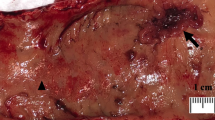Abstract
The mucin-associated antigens Tn, sialosyl-Tn (STn), T and sialosyl-T (STAg) antigens accumulate through aberrant and incomplete glycosylation in malignant epithelial cells. Their diagnostic and prognostic significance in tumours of the colon and cervix has been described, and a possible role for Tn antigen in cell-to-cell adhesion has been suggested. These antigens have been demonstrated through peanut agglutinin (PNA) lectin binding and more recently using specific monoclonal antisera. Differences between the two methods have been described, which may be due to fixation schedules and/or specificity. We have investigated the effect of fixation on the binding of biotinylated PNA lectin and compared its reactivity with the immunoreactivity of monoclonal antisera to Tn, STn, T and STAg antigens in benign and malignant epithelium of the gall bladder, extrahepatic bile ducts and ampulla of Vater. We found that short-term fixation in formol sublimate resulted in poor PNA binding. All other tested fixation schedules showed strong perinuclear binding, similar to that found on cryostat sections. When compared with monoclonal antisera, PNA binding demonstrated the lowest specificity in benign epithelium. In both benign and malignant epithelium, the two methods cannot substitute for each other. STn and STAg antigens were found to be oncodevelopmental throughout the extrahepatic biliary tract. When used in a panel, they are useful as diagnostic markers of malignancy in gall bladder epithelium.
Similar content being viewed by others
References
Itzkowitz S. Carbohydrate changes in colon carcinoma.APMIS 1992:100 (Suppl. 27); 173–80.
Carneiro F, Santos L, David L, et al. T (Thomsen-Friedenreich) antigen and other simple mucin-type carbohydrate antigens in precursor lesions of gastric carcinoma.Histopathology 1994:24; 105–13.
Lotan R, Skutelsky E, Danon D, Sharon N. The purification and specificity of the anti-T lectin from peanut (Arachis hypogaea).J Biol Chem 1975:250; 8518–23.
Feizi T. Carbohydrate antigens in human cancer.Cancer Surveys 1985:4; 245–60.
Itzkowitz SH, Yuan M, Montgomery, CK, et al. Expression of Tn, Sialosyl-Tn and T antigens in human colon cancer.Cancer Res 1989:49; 197–204.
Yonezawa S, Tachikawa T, Shin S, Sato E. Sialosyl-Tn antigen. Its distribution in normal human tissues and expression in adenocarcinomas.Am J Clin Pathol 1992:98; 167–74.
Huang J, Byrd JC, Siddiki B, Yuan M, Lau E, Kim YS. Monoclonal antibodies against partially deglycosylated colon cancer mucin that recognise Tn antigen.Dis Markers 1992:10; 81–94.
Itzkowitz S, Bloom EJ, Kokal WA, Modin G, Hakomori S, Kim YS, Sialosyl-Tn. A novel mucin antigen associated with prognosis in colorectal cancer patients.Cancer 1990:66, 1960–6.
Osako M, Yonezawa S, Siddiki B, et al. Immunohistochemical study of mucin carbohydrates and core proteins in human pancreatic tumours.Cancer 1993:71; 2191–9.
Hirao T, Sakamoto Y, Kamada M, Hamada S-I, Aono T. Tn antigen, a marker of potential for metastasis of uterine cervix cancer cells.Cancer 1993:72; 154–9.
Cooper HS. Lectins as probes in histochemistry and immunohistochemistry: the peanut (Arachis hypogaea) lectin.Hum Pathol 1984:15; 904–6.
Yuan M, Itzkowitz SH, Boland CR, et al. Comparison of T-antigen expression in normal, premalignant and malignant human colonic tissue using lectin and antibody immunohistochemistry.Cancer Res 1986:46; 4841–7.
Allison RT. The effects of various fixatives on subsequent lectin binding to tissue sections.Histochem J 1987:19; 65–74.
Sato A, Spicer SS: Ultrastructural visualization of galactosyl residues in various alimentary epithelial cells with the peanut lectin-horseradish peroxidase procedure.Histochemistry 1982:73, 607–24
Boland CR, Lance P, Levin P, Riddell RH, Kim YS. Lectin binding indicates an abnormality of the goblet cell glycoconjugates in ulcerative colitis (UC).Gastroenterology 1982:82; 1021.
Boland CR, Montogomery CK, Kim YS. A cancer-associated mucin alteration in benign colonic polyps.Gastroenterology 1982:82; 664–72.
Boland CR, Montgomery CK, Kim YS. Alterations in human colonic mucin occurring with cellular differentiated and malignant transformation.Proc Natl Acad Sci USA 1982:79, 2051–5.
Cooper HS, Reuter VE: Peanut lectin-binding sites in polyps of the colon and rectum: adenomas, hyperplastic polyps and adenomas with carcinoma in situ.Lab Invest 1983:49, 655–61.
Springer GF, Murthy MS, Desai PR, et al. Patient's immune response to breast and lung carcinoma-associated Thomsen-Friedenreich (T) specificity.Klin-Wochenschr 1982:60; 121–31.
Springer GF, Cheingsong-Popov R, Schirrmacher V, Desai PR, Tegtmeyer H. Proposed molecular basis of murine tumour cell-hepatocyte interaction.J Biol Chem 1983:258; 5702–8.
Putz P, Willems G. Proliferative changes in the epithelium of the human lithiasic gall bladder.J Natl Cancer Inst 1978:60; 283–7.
Author information
Authors and Affiliations
Rights and permissions
About this article
Cite this article
Maxwell, P., Davis, R.I. & Sloan, J.M. Mucin-associated T antigens in benign and malignant epithelium of the gall bladder, extrahepatic bile ducts and ampulla of Vater. Glycosylation & Disease 1, 83–88 (1994). https://doi.org/10.1007/BF00919293
Received:
Accepted:
Published:
Issue Date:
DOI: https://doi.org/10.1007/BF00919293




